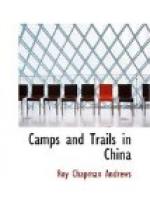On April 5, we received the first mail in nearly three months and our share amounted to 105 letters besides a great quantity of magazines. Wu had ridden to Teng-yueh for us and, as well as the greatly desired mail, had a basket of delicious vegetables and a sheaf of Reuter’s cablegrams which were kindly sent by Messrs. Palmer and Abertsen, gentlemen in the employ of the Chinese Customs, who had cared for our mail. Mr. Abertsen also sent a note telling us of a good hunting ground near Teng-yueh.
We spent an entire afternoon and evening over our letters and papers and, through them, began to get in touch with the world again. It is strange how little one misses the morning newspaper once one is beyond its reach and has properly adjusted one’s mental perspective. And it is just as strange how essential it all seems immediately one is again within reach of such adjuncts of civilization.
On April 6, we had the first rain for weeks. The water fell in torrents, and the roar, as it drummed upon the tent, was so incessant that we could barely hear each other shout. Because of the long dry spell our camp had not been made with reference to weather and during the night I waked to find that we were in the middle of a pond with fifteen inches of water in the tent. Shoes, clothes, guns, and cameras were soaked, and the surface of the water was only an inch below the bottoms of our cots. This was the beginning of a ten days’ rain after which we had six weeks of as delightful weather as one could wish.
CHAPTER XXXV
TENG-YUEH; A LINK WITH CIVILIZATION
After a week on the pass above Ho-mu-shu we shifted camp to a village called Tai-ping-pu, ten miles nearer Teng-yueh on the same road. The ride along the summit of the mountain was a delight, for we passed through grove after grove of rhododendrons in full blossom. The trees were sometimes thirty feet in height and the red flowers glowed like clusters of living coals among their dark green leaves. In the northern part of Yuen-nan the rhododendrons grow above other timber line on mountains where it is too high even for spruces.
It rained continually during our stay at Tai-ping-pu. I had another attack of the Salween malaria and for five or six days could do little work. Heller, however, made good use of his time and killed a beautiful horned pheasant, Temmick’s tragopan (Ceriornis temmincki), besides half a dozen langurs of the same species as those we had collected on the Nam-ting River. He also was fortunate in shooting one of the huge flying squirrels (Petaurista yunnanensis) which we had hoped to get at Wei-hsi. He saw the animal in the upper branches of a dead tree on the first evening we were in Tai-ping-pu but was not able to get a shot. The next night he watched the same spot and killed the squirrel with a charge of “fours.” It measured forty-two and one-quarter inches from the nose to the end of the




